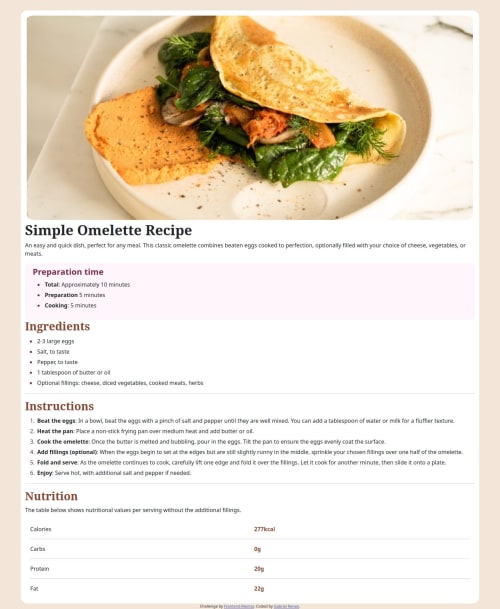Responsive recipe page using HTML, CSS and Bootstrap

Solution retrospective
Well, i'm happy for everthing, even though it's simple, i believe it's the first project that i truly made by myself, (with some AI and friend help), and i am happy to see that i can make the project similar to its standards, but anyways, im not ignorant on the fact that the fonts aren't properly setted up, altough it looks similar; i tried to correct this, but i didn't know how to attribute it (i just linked); and also the lines in the tabble are not in the correct width, anyways, just to contextualize, i wanted to train bootstrap more, and maybe by this reason i couldn't customize the elements so much, but i insisted because i really wanted to train my knowledge on this, also, the styles are sometimes in the elements, sometimes inside the style tag; i think i have used the style tag to more general stylishment, for me this is a good programming practice, but i'm open to feedback.
What challenges did you encounter, and how did you overcome them?The first was with the colors, how to declare them as variables (i've never used HSL pattern), in wich i used AI, i also used AI to see how to attribute the linked fonts to certain elements (it didn't help), and the most difficult thing was the image responsivity, in wich i used AI to respond me a question on how to make the image addapt to the screen size, and also asked to a friend on how to make the "@media" work properly.
What specific areas of your project would you like help with?I would like to know how to attribute the fonts that i linked to an element, and the limits of customization on bootstrap, because my friend told me that we cant customize some elements aspects when using bootstrap; and for last, but not less important (okay, a tiny bit less), know a little more about HSL color pattern.
Please log in to post a comment
Log in with GitHubCommunity feedback
No feedback yet. Be the first to give feedback on GabrielRenan11's solution.
Join our Discord community
Join thousands of Frontend Mentor community members taking the challenges, sharing resources, helping each other, and chatting about all things front-end!
Join our Discord